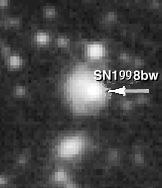Catching Enigmatic Gamma-Ray
|
|
"For a few hundredths of a second, gamma-ray bursters produce the most extreme flash of any astronomical object," says Bruce Grossan of the Physics Division. "A gamma-ray burst is likely to occur somewhere in the sky perhaps once a day, but until recently detectors have been primitive; the best they could do was point to a few degrees of sky and tell you, `it was somewhere over there.'"
Accidentally discovered in 1967 by satellites looking for nuclear tests, gamma-ray bursts are so unpredictable, so evanescent, and so hard to pinpoint that nobody knows what causes them. Only on rare occasions have astronomers using the most powerful telescopes been able to associate gamma-ray bursts with optical emissions persisting a few days or more.
Quicker response time should make it possible to catch dozens of bursters in the act and match more of them with objects that shine in wavelengths visible to the human eye. Using the Automated Patrol Telescope (APT) located at Siding Spring Observatory in Australia and operated by the University of New South Wales, Grossan and his colleagues, including Saul Perlmutter, have devised a rapid-response system that, within a few seconds, can train the telescope on the region of sky where sentinel satellites have detected a burst.
"The APT is a modest-looking instrument, very squat," Grossan says, "but it combines a wide field of view with a wide CCD camera," which can presently cover a region of sky two by three degrees wide -- roughly 30 times the area of the moon.
Three seconds after a burst, the APT receives a signal from one or more satellites and interrupts its regular observation program; within half a minute it fixes on the portion of sky where the trigger event occurred. Observations continue up to four days.
"The operation is 90 percent automatic," says Grossan. "In fact, the most interesting gamma-ray bursts the APT observed on my last trip to Australia took place while I was at dinner."
Those included two of the most unusual gamma-ray bursts astronomers have ever witnessed. An astonishingly bright burst last December was more than three-fourths as old as the universe itself -- visible 12 billion light years away.
But the gamma-ray burster seen this year on April 25 in the southern constellation Telescopium was stranger by far, producing hundreds of thousands of times less peak gamma-ray energy. At only 140 million light years away, the event was much more recent. Shortly after it was detected a supernova bloomed at virtually the same spot.
No gamma-ray burster has ever been identified with a supernova before. No supernova has ever produced more radio energy. The odds against a coincidence have been conservatively estimated at one in 10,000.
One scenario calls for the highly asymmetric explosion of a star 35 times as massive as the sun, which emits a jet of matter moving at a significant fraction of the speed of light -- the source of the gamma-ray burst -- while the remainder collapses into a black hole.
"It's too soon to say what caused this event," Grossan says. "It could be completely new physics, something that comes along maybe once in the lifetime of a satellite like BeppoSAX," the Dutch-Italian satellite that detected the burst. "But our rapid-response system, working with NASA's Compton Gamma Ray Observatory, could find as many as two to five such events a year. Berkeley Lab is really poised to investigate this new kind of gamma-ray-bursting supernova and to find more optically-emitting gamma-ray bursters of all kinds than ever before."
